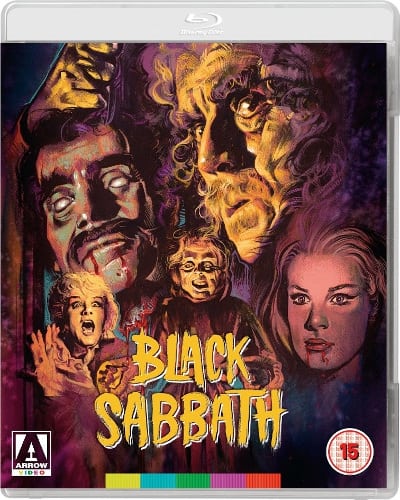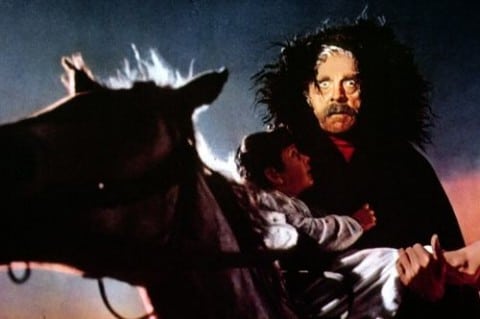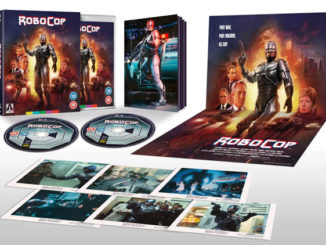Black Sabbath (1963)
Directed by: Mario Bava
Written by: Alberto Bevilacqua, Aleksei Tolstoy, Franco Lucentini, Marcello Fondato, Mario Bava
Starring: Boris Karloff, Jacqueline Pierreux, Mark Damon, Michèle Mercier
AKA I TRE VOLTI DELLA PAURA, THE THREE FACES OF FEAR
Italy
AVAILABLE ON BLU-RAY AND DVD: NOW, from ARROW VIDEO
RUNNING TIME: 92 min
REVIEWED BY: Dr Lenera, Official HCF Critic
The Telephone: French call-girl Rosy returns to her basement apartment at night when she immediately receives a series of strange phone calls. The caller soon identifies himself as Frank, her ex-pimp who has recently escaped from prison, Rosy’s testimony having put her there. Rosy phones Mary, an ex-girlfriend with whom Rosy has become estranged, and she comes over to help her, but Frank calls again, promising that no matter what Rosy does, he will have his revenge….
The Wurdulak: In 19th Century Russia, young nobleman Vladimir Durfe finds a beheaded corpse with a knife plunged into its heart. He is offered a room to stay at a house where a family awaits the return of the father Gorca, who has gone to fight the wurdalak Alibeg, a wurdulak being a living cadaver who feeds on human blood, nd especially of close friends and family members….
The Drop Of Water: In Victorian England, Nurse Helen Chester, called to prepare the corpse of an elderly medium for her burial, takes an elaborate sapphire ring on its finger, accidentally tipping over a glass of water which drips on the floor as she is then assailed by a fly. Chester takes her ring home to her flat, where that night the fly returns and continues to pester her, the lights in her apartment go out and the sound of the dripping water continues from various locations in the house….
Films which are made up of several short stories seem to flourish especially well in the horror genre, and around Halloween several years ago I reviewed what might be the best: the 1946 British classic Dead Of Night. However, there is one film [and, in my opinion, only one, despite all those hugely enjoyable Amicus efforts of the 60’s and early 70’s, and a few impressive works that have come out recently] that truly gives it a run for its money. That film is Mario Bava’s Black Sabbath, which is a good title [and was appropriated by the band of the same name when, originally called Earth, they noticed that a cinema showing the film had a longer queue of people waiting to get in then a gig they were playing at], though I prefer the original Italian one, which translates as The Three Faces Of Fear. Like most films of this kind, the tales vary in quality, but only because one is good, one is very good and one is absolutely superb and almost a textbook exercise in how to scare, while of course all three look fabulous. As a whole the film, while being by its very nature unable to be as totally satisfactory as some of Bava’s very best pictures, is a fascinating compilation of the director’s favourite subjects and themes and might be the film to see if you want to get a good idea of what he was about but were only able to see one film.
It was the first of nine films where, prompted by the US success of Bava’s Black Sunday and Hercules, American International Pictures would collaborate with Italian production company Galatea. Bava wanted to show fear striking mankind in different time periods and supposedly found three stories for his screenwriters Alberto Bevilacqua and Marcello Fondato to adapt, but it seems like they actually made up two of them themselves, because there’s no evidence of Anton Checkov and Guy de Maupassant, who are credited, writing such tales, though some have claimed that the origins of The Drop Of Water lie in Between Three And Three Thirty by Franco Lucentini. A certain Aleksie Tolstoy did write Curse Of The Wurdulak, the definite inspiration for The Wurdulak, but Ivan Tolstoy never existed. That story featured a true horror star, Boris Karloff, whom early on it was decided would also act as the film’s ‘host’ as he had done in his recent TV series Thriller. Sadly, Bava later blamed himself for speeding up Karloff’s death when Karloff convinced him that he would be fine to do his final scene, an amusing ‘fourth wall’ coda requested by AIP when he’s seen astride a hobby horse as people pass branches in front of the camera. Karloff’s respiratory problems got worse and worse afterwards and his health gradually deteriorated until his death in 1969. Ironically, the US cut didn’t even use this footage, though AIP did shoot new Karloff stuff. They heavily altered the film, including replacing Roberto Nicolosi’s score with one by Les Baxter, changing the order of the stories, altering gory shots from The Wurdulak and changing sound effects on The Drop Of Water, though the only real damage they did was concerning The Telephone, where they removed the allusions to prostitution and lesbianism, added new footage, and totally changed the ending to a rather illogical supernatural explanation for the goings-ons. Black Sabbath was a box office success on both sides of the Atlantic and remains one of Bava’s most-seen films.
The Telephone
I’m only going to refer to the Italian version from now on until the final paragraph of the review proper, and it’s just as well with regard to The Telephone, because this episode was made incoherent and pointless for export release. In its original cut, it’s far better, though in my opinion it’s still the weakest of the three stories, and can almost be said to be an appetiser for the other two, but Bava did order the tales so they had a cumulative effect, and The Telephone is still a fine exercise in low-key suspense, making much mileage of how frightening the repeated ringing of a phone can be, then telling us who is really behind the ringing half way through so, in Hitchcock fashion, the tension is actually increased, until we get one of the most effective ‘someone sneaking into someone’s house’ scenes ever and an ironic climax which Bava would repeat several times later in his career. Each of the stories in Black Sabbath concern one of Bava’s favourite themes, and here we have corrupted sexuality leading to violent death – not to mention the hint of lesbian rape which must have really had the AIP honchos worried. The Telephone also has a very unpleasant strangling, but it’s the sleazy atmosphere, achieved despite everything set in one apartment with only three characters, which is most striking, aided immensely by the bright, candy-coloured lighting schemes. You can see the seeds of The Whip And The Body and the entire giallo genre [which of course Bava invented] here [yes, we have the black gloves!], and it also may have influenced the opening of Scream.
The Wurdulak
This second and final Bava exploration of vampirism was also the only time Karloff played a vampire, and his performance, easily the best of his later years, is so good that it transcends the fact that he’s dubbed into Italian. He’s scary, but also has moments of dignity and even sadness. His introduction, as he slowly returns to his family ‘changed’ accompanied by an eerily beautiful blue haze, is unforgettable, though even more spine chilling is the return of Ivan the young boy, his eerie cries of “Mama, I’m cold” augmented by an odd sound recording of his voice. The idea of a vampire feeding on his family is a disturbing one, and oddly made more so by most of the bloodsucking occurring off-screen. Instead, the uneasy moments come from more subtle bits like Gorca cradling his grandson, which is both a grandfather showing affection and also has an unpleasant whiff of paedophilia. The slow pacing, far from being detrimental, strengthens the extraordinary Gothic feel, the story taking place in a land where everything seems drained of life yet still looks fabulous, with cinematographer Ubaldo Terzani conjuring up simply beautiful shots of bleak, fog-strewn landscapes, old ruins and sinister houses. Often, plants and trees are placed in the foreground, creating an almost 3D-like effect. The entirely studio-created world here is one of the best realised Gothic ones in cinema, rivalling the best of Hammer and Universal, while the story, despite a romantic element, is appropriately nihilistic in keeping with the view of the world that Bava was developing, and one of the first horror films in which evil wins. The favoured Bava theme here is the destruction of the family from within, and there are perhaps seeds of Lisa And The Devil, though it’s perhaps best seen as a semi-sequel to Black Sunday. I just wish he’d made it as a feature.
The Drop Of Water
This absolutely terrified me when I first saw Black Sabbath [it was actually the American version], and, though I’ve now seen it too many times for it to work anywhere near as well, it still makes me uneasy and jump near the end. If you’re watching it for the first time, I just hope that one of your taps doesn’t drip, because it may seriously keep you awake and frighten you. Me, I didn’t want to hear a damn dripping tap anywhere for several days afterwards. Dealing with Bava’s other two favourite subjects – guilt and demons of the mind – it’s a near perfect exercise in screen terror. It’s creepy right from the very beginning when, at the medium’s house, a clear forerunner to the Villa Grapps in Kill, Baby Kill, we see the old lady’s body, her face looking very scary indeed, and oddly more so because if you think about it they don’t really attempt to disguise the fact that it’s a dummy. Helen closes the corpse’s eyes, then in the next scene, they’re open again, this really sending a shudder up the spine because of Bava’s mastery of horror. A modern film would probably have shown the eyes open, lessening the impact, or given us some kind of sign that it’s coming [orchestral swell on the soundtrack, etc.]. The only clue we get here is the nurse’s shocked reaction, sending a chill on its own, then the shot of the eyes open again, causing another chill. Then we get just incredible tension building back in Helen’s apartment, Bava superbly tightening the screws, until we get a climactic series of shocks which still work incredibly well. All the time, the whole episode looks amazing, parts of Helen’s apartment being bathed in green and pink which slightly flash. Even if it’s due to lights outside, they wouldn’t have quite this effect – t’s simply because Bava, who was a painter before a filmmaker, was also an absolute genius in creative lighting which not only looks stunning but is extremely effective. The Drop Of Water is a mini horror masterpiece.
Bavas’s films aren’t known for great performances but Jacqueline Pierreux does perfectly well in registering fear in The Drop Of Water and familiar Italian leading man of the time Mark Damon is a decent ‘hero’ in The Wurdulak. Roberto Nicolosi’s score cleverly alters its two main themes for each story, and knows when to hold back so sound effects, or sometimes nothing at all, can take over. It makes for an interesting comparison with Les Baxter’s score for the US version which, while it uses the same main themes, is much more bombastic and prevalent, as well as lacking the contemporary jazz/pop touches that Nicolosi sometimes brings. Now to my mind, the light-hearted mood of Karloff’s intro and outro, though I never tire of seeing the great man, jars a bit with the seriousness of the rest of the film, and The Telephone, while still good, can’t help but lag behind the other two stories in quality, but Black Sabbath remains a perfect example of the pure genius that was Bava, a man able to make mere schlock horror into art, art that’s beautiful, disturbing and profound [take, for instance, the cautionary but un-judgemental moral element to his work], and able to do it with budgets that wouldn’t even reach to lunch money in a similar Hollywood product of the time. For a simple example of his brilliance, just pay attention to the last shot of The Wurdulak, and notice how all three of the faces that you see are lit in a different way.
Rating: 









Arrow Video first released Black Sabbath in 2013 in a set which contained a Blu-ray containing both versions of the film and some special features, and also two DVDs, each of which had one of the versions on it and which divided up the extras. This time, they are releasing the Blu-ray on its own, and also the first of the two DVDs on its own. This means that if you want to own the American cut, and it’s certainly worth owning as it features Karloff’s voice, you have to get the Blu-ray. Arrow weren’t able to send the Blu-ray over to us to review, and I don’t own it so I can’t comment on the exclusive extras on it. However, the DVD is certainly worth having if you still haven’t made the jump to Blu or just want a cheaper introduction to one of the seminal Italian horror directors. Watched on my Blu-ray player, the upscaled DVD looks considerably better than the old Anchor Bay DVD. Yes, it shows up the fakery of some of the sets and makes some of the makeup look more obvious, but then Bava was rarely aiming for realism anyway. Those beautiful Bava colour schemes look even better and there’s just the right amount of grain.
The introduction by Alan Jones is short [three minutes long!] but covers a surprising number of bases. The audio commentary by Bava expert Tim Lucas is taken from the Anchor Bay [he sometimes updates his talk tracks], though it’s very good anyway despite some lengthy pauses and provides the usual great mixture of background information and appreciation. He gives you the lowdown on everything from what other Bava films the props appeared in to how shots were achieved. The 15 minute interview documentary A Life in Film allows star Mark Damon to tell his career story and its an interesting one, going from pretty-boy teen actor to Spaghetti western star to producer of films as diverse as Das Boot and The Neverending Story. Along the way he takes credit for Clint Eastwood’s hiring as The Man with No Name on Fistful of Dollars, and reckons that he directed most of The Pit And The Pendulum. “Ummm” is all I say to that.
In whatever form you buy it, Black Sabbath is an essential purchase for the true horror fan and probably the best film for the Bava virgin to obtain. You’ll be hooked….
SPECIAL FEATURES:
BLU-RAY
*High Definition Blu-ray (1080p) presentation of two versions of the film; I tre volti della paura the European version with score by Roberto Nicolosi & Black Sabbath the re-edited and re-dubbed AIP version with Les Baxter score
*English SDH subtitles for English Audio and a new English subtitle translation of the Italian audio
*Audio Commentary with Bava biographer and expert Tim Lucas
*Twice the Fear, A comparison of the different versions of the film
DVD
*High Definition transfer of the European version of the film; I tre volti della paura with score by Roberto Nicolosi
*Optional English subtitles
*Audio Commentary with Bava biographer and expert Tim Lucas
*Introduction to the film by author and critic Alan Jones
*A Life In Film, An Interview with star Mark Damon
*International Trailer
*US Trailer
*Italian Trailer
*TV and Radio Spots








Be the first to comment